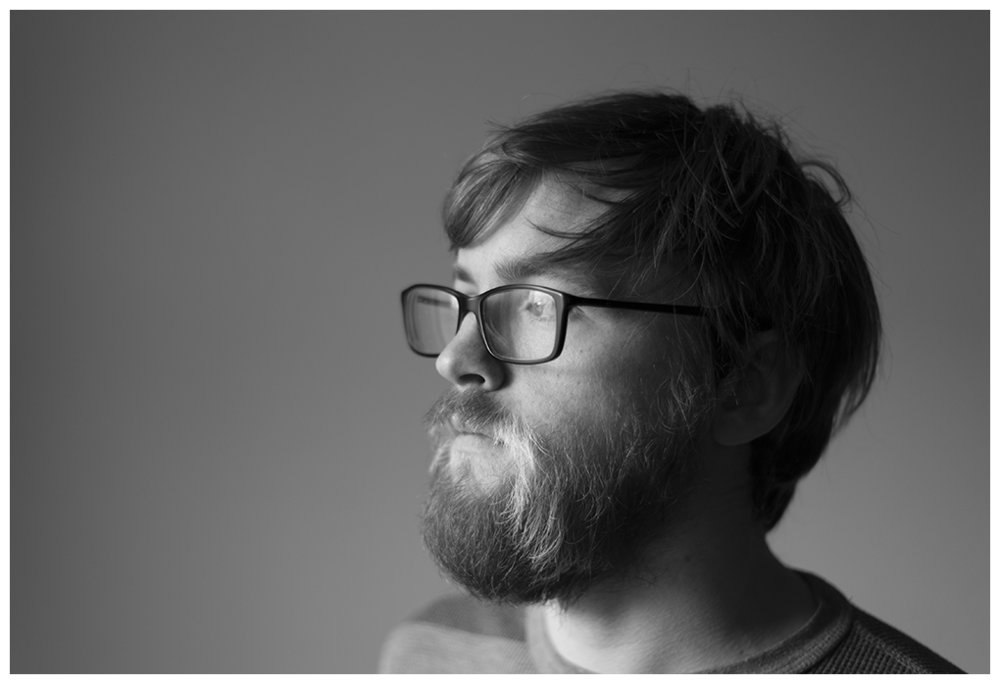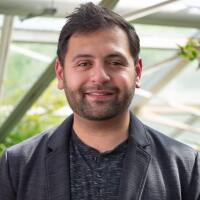
Kurt Roembke of Soundwalk (Photo/Jack Cantey)
With the next Fort Wayne SOUP (learn more) micro-grant dinner coming up this Thursday, I caught up with Soundwalk's Kurt Roembke, the first micro-grant winner, to learn more about his creative project designed to enhance the Fort Wayne community by pairing locally composed sounds with local landscapes.
Roembke is a music composer and performer and media professional based in Fort Wayne. He is also a co-worker and personal friend of mine, so I was excited to learn more about this project and just what it takes to be a successful presenter at Fort Wayne SOUP.
About Soundwalk
Roembke and Michael Sullivan, app developer from Elemental Spark, are developing an immersive smartphone application called Soundwalk, which will pair music composed by Roembke with physical objects within a geographic space. Lindenwood Cemetery on Fort Wayne’s west side is the first area being mapped via the app.
“What we’ve developed so far and what we plan to be our final form is basically people take their phone, they download the app, and they really could put it in their pocket at that point,” Roembke said.
Once app users are walking, the experience would be hands-free and completely controlled by the app at that point. People will be able to walk from place to place while listening to music composed specifically for each area of the cemetery.
Users would then be able to check the app to see what music is playing at certain locations. The music will change based on the physical features of the area or the history behind the people buried nearby. For example, if there is a memorial to a former baseball player, the music might be inspired by that.
At Lindenwood Cemetery, app users would be able to jump right into the experience once they arrive at the cemetery. People will be able to start their walks near the entrance, but users could really be able to start from anywhere. Although people can technically use the app as part of a group, Roembke believes many people might choose to make it an individual experience within the space.
“There’s something about the nature of walking through a cemetery that feels a little more solitary and less group-oriented,” Roembke said.
The initial vision in Roembke's mind for the app was a two-dimensional sound space where users would walk from location to location and the music would do a seamless crossfade transition. With the influx of mini-grant money from SOUP, Roembke has expanded his vision to create a more interactive user experience with the app.
“We basically started to develop it as a three-dimensional sound space,” Roembke said. “What that means is, the app pays attention to where you are in comparison to the location sound sources.”
Even though app users would still have their phones in their pockets, Roembke explains that their individual movements would create a more personal interaction within a three-dimensional space.
“Say if you walk to the right of a certain tree that has a tone attached to it,” Roembke said. “I could put a musical note that reverberates from this certain tree and if you walk past it to its right, you’ll hear it in your left ear and you’ll hear it get closer to you as you get closer to it.”
This would lead to some fairly inventive artistic experiences for app users.
“There are sections where I play with that where there will be five trees and each one has a different musical harmony,” Roembke said. “The user can walk between the different trees and almost create chord progressions."
Rediscovering Lindenwood Cemetery
You might be asking “why Lindenwood Cemetery”? With numerous parks and features in Fort Wayne, I was curious to see why Roembke was starting with this particular location.
Lindenwood Cemetery has a rich history going back to 1859 and many of Fort Wayne’s most notable historical figures are buried there. The 175 acre park-like cemetery holds more than 69,000 interments making it one of the largest cemeteries in Indiana. Lindenwood Cemetery was added to the National Register of Historic Places in 1978.
Roembke’s own personal journey with Lindenwood Cemetery started with just a simple walk.
“I got into the habit of taking pictures and then basing music on the pictures based on physical features,” Roembke said. “When I did the art exhibition with Andrew Dubach called "Copula"...I would basically look at his sculptures and then interpret them and compose a music piece that was using visual elements and inspiring sound off of them.”
After visiting Lindenwood Cemetery with a friend, Roembke was hooked on the artistic appeal of the space after seeing numerous visual elements that could inspire music pieces.
“I started taking pictures and then it just felt like the more I was walking around, I was taking more and more pictures,” Roembke said. “And then I was like, ‘I can make quite a few pieces based on this place.’”
Around this time period, Roembke was working on soundtracks for videos games and initially thought about having a cemetery be a part of one of those games - and that’s where the basic idea for Soundwalk came together.
“I went home and thought about it some more and started plotting out points on a map and kind of imagining what I would use musically for each section,” Roembke said. “I was like ‘I guess I can do the whole [cemetery], technically.’”
There is mystery to Lindenwood Cemetery and a feeling of rediscovery along its winding paths and historical architecture from past days when the cemetery was a used as a place of leisure.
“People don’t really use it as a park anymore,” Roembke said. “People aren’t having picnics there anymore.”
For one particular “forgotten” area of the cemetery, Roembke described what he hears in that space.
“The music there I’m imaging is going to be almost adventurous and it will have the feeling that you’re in an adventure almost when you walk to that back part,” Roembke said.
App users can either be active or passive listeners while listening to the music through the app.
“The more active they are as a listener, it’s going to increase the value,” Roembke said. “But, if someone just puts it on and walks around and just sticks to their own head and kind of has a contemplative experience, that’s fine.”
Ultimately it will be up to the users to determine how they would like to use the app and not every user will feel the exact same way about the experience.
“There’s a little bit like the music is trying to get people to feel a certain way, but then I think it’s because that’s how the space initially made me feel,” Roembke said. “It’s a reflection of my initial feelings in the cemetery and then hopefully translating it to the [app users].”
Presenting at Fort Wayne SOUP Roembke was successful in communicating this vision for the app to the audience at the first Fort Wayne SOUP event in March 2017 where he went up against three other worthy competitors for the night’s grand prize.
Each presenter did a four minute presentation about their project followed by a four minute question and answer session with SOUP attendees. A major selling point for Soundwalk was the Fort Wayne tie-in for Roembke’s project.
“I think what sold to SOUP was that it was a local composer making music that was tied specifically to the Fort Wayne landscape and specifically for local Fort Wayne people to experience for free,” Roembke said.
In addition to this, the app's ability to be expanded to other locations in Fort Wayne and beyond was another major selling point.
As for advice for people interested in pitching to Fort Wayne SOUP in the future, Roembke has a few pointers.
“I prepared quite a bit and I had a plan for how I was going to do it - how I was going do it for the money I was going to raise there at SOUP,” Roembke said. “A big selling point for the SOUP was that I could fund it with the money there and I’m not going to need much more, if I do need any more.”
Beyond the an overview of costs, Roembke recommends that would-be participants try determine if there any legal issues surrounding their idea and if there are any additional funding sources if the mini-grant money is not enough.
Coaching sessions before and after the event are provided by young professionals from Fort Wayne Confluence.
“[Fort Wayne SOUP] paired everyone with the Confluence group and the whole point of that was to basically level the playing field to a certain extent,” Roembke said.
Roembke described the environment at the first Fort Wayne SOUP as having reasonable level of competitiveness.
“It’s definitely not like a 'Shark Tank' or anything,” Roembke said. "And the [Q&A session questions] were all just people curious about your project.”
Upon being asked how he feels at this stage, Roembke described his emotions in one word.
“Fear - quite literally - I’m serious,” Roembke said. “It’s pretty scary. It’s kind of the same emotions that I had when I was doing "Copula," except amplified like crazy.”
There is also greater public knowledge about Soundwalk with features on local media outlets due to winning the mini-grant money.
“I feel the pressure to sort of deliver to a certain extent, which is good, but I think I’m being a little hard on myself,” Roembke said. “I think it will be good - I think people will really like it. It’s hard to work on something and be thinking about the audience so much, because you just cripple yourself and then you don’t get anything done.”
Learn more
For more information about Fort Wayne SOUP, visit their website at fortwaynesoup.org. The next SOUP event is Thursday, June 29 from 6:30 PM - 8:30 PM at The Summit.
For more information about Kurt Roembke, visit his website at spaceowlproductions.com.



